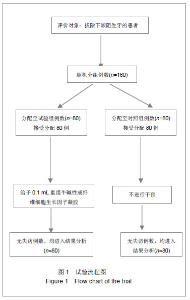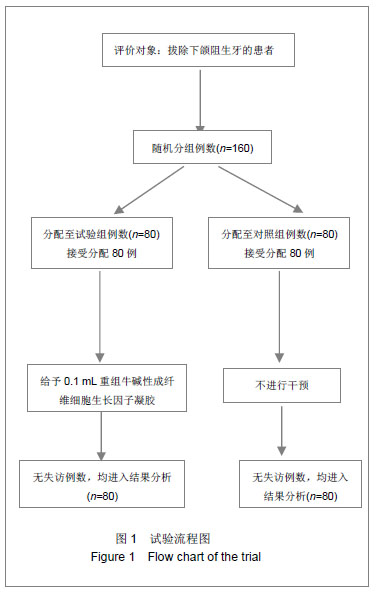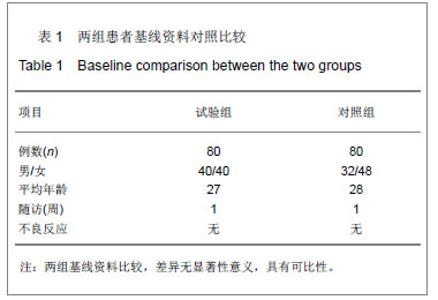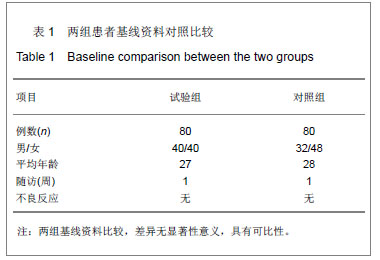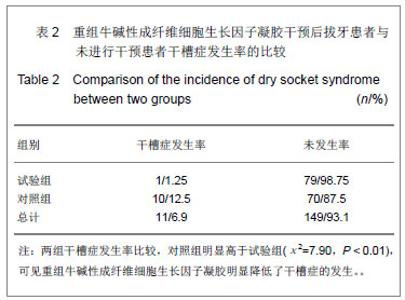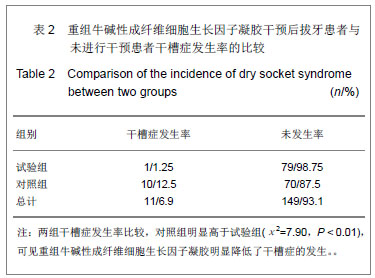| [1]邱蔚六.口腔颌面外科学[M].6版.北京:人民卫生出版社,2008: 96-98.[2]Blum IR. Contemporary views on dry socket (alveolar osteitis): a clinical appraisal of standardization, aetiopathogenesis and management: a critical review. Int J Oral Maxillofac Surg. 2002; 31(3):309-317.[3]Kolokythas A, Olech E, Miloro M. Alveolar osteitis: a comprehensive review of concepts and controversies. Int J Dent. 2010;2010:249073.[4]张震康.口腔颌面外科学[M].北京:北京大学医学出版社,2007: 112.[5]Clauser B, Barone R, Briccoli L, et al. Complications in surgical removal of mandibular third molars. rva Stomatol. 2009;58(7-8):359-366.[6]Bouloux GF,Steed MB,Perciaccante VJ.Complications of third molar surgery. Oral Maxillofac Surg Clin North Am.2007;19(1): 117-128. [7]Sridhar V, Wali GG, Shyla HN. Evaluation of the perioperative use of 0.2% chlorhexidine gluconate for the prevention of alveolar osteitis after the extraction of impacted mandibular third molars: a clinical study. J Maxillofac Oral Surg. 2011; 10(2):101-111. [8]黄素碧,易强英,张杰敏,等.重组牛碱性成纤维细胞生长因子与胰岛素联合应用治疗压疮创面:随机对照[J].中国组织工程研究与临床康复,2011,15(7):1300-1304.[9]程飚,付小兵,盛志勇,等. 碱性成纤维细胞生长因子对肌成纤维细胞生长的作用及其对创面愈合的影响[J].中华医学杂志, 2002, 82(17):1187-1191.[10]Yuan Q, Kubo T, Doi K, et al. Effect of combined application of bFGF and inorganic polyphosphate on bioactivities of osteoblasts and initial bone regeneration. Acta Biomater. 2009; 5(5):1716-1724. [11]刘晓花,商文芝,杜毅,等.体外培养成纤维生长因子对人牙周膜成纤维细胞生物学特性的影响[J].临床口腔医学杂志, 2006,22(6): 339-341.[12]王卓为,潘巨利,王学玖,等. 口腔组织补片预防干槽症的疗效观察[J]. 实用医院临床杂志,2012,9(4):169-170.[13]白诚,施生根,李莉莉,等. 脱细胞异体真皮组织补片在智齿拔除中的应用[J]. 中国组织工程研究与临床康复, 2011,15(34): 6457-6460.[14]温宁,韩亮,陆怀秀,等. 碱性成纤维细胞生长因子对阻生齿干槽症发生的预防试验[J]. 中国临床康复,2004,8(5):858-859.[15]韩亮,储冰峰. 碱性成纤维细胞生长因子预防下颌阻生齿拔除后干槽症发生[J]. 第四军医大学学报,1998,19(6):715-716.[16]Penarrocha M, Sanchis JM, Saez U, et al.Oral hygiene and postoperative pain after mandibular third molar surgery. Oral Surg Oral Med Oral Pathol Oral Radiol Endod. 2001;92(3): 260-264.[17]Ren YF, Malmstrom HS. Effectiveness of antibiotic prophylaxis in third molar surgery: a meta-analysis of randomised controlled clinical trials. J Oral Maxillofac Surg. 2007;65(10):1909-1921. [18]Torres-Lagares D, Serrera-Figallo MA, Romero-Ruíz MM, et al. date on dry socket: a review of the literature. Med Oral Patol Oral Cir Bucal. 2005;10(1):81-5; 77-81.. [19]Jerjes W, El-Maaytah M, Swinson B, et al. Experience versus complication rate in third molar surgery. Head Face Med. 2006;2:14. [20]耿温琦.下颌阻生智齿[M].2 版.北京:人民卫生出版社, 2008: 171-184.[21]许竞.2种术式拔除下颌阻生第三磨牙术后干槽症及其发生机制探讨[J].广东牙病防治,2011,19(1):37-39.[22]Garcia AG, Grana PM, Sampedro FG, et al.Does oral contraceptive use affect the incidence of complications after extraction of a mandibular third molar?. Br Dent J 2003; 194 (8):453-455. [23]Monaco G, Staffolani C, Gatto MR, et al.Antibiotic therapy in impacted third molar surgery. Eur J Oral Sci. 1999;107(6): 437-441.[24]Al-Belasy FA. The relationship of "shisha" (water pipe) smoking to postextraction dry socket. J Oral Maxillofac Surg. 2004;62(1):10-14. PMID:14699542[25]Oginni FO. Dry socket: a prospective study of prevalent risk factors in a Nigerian population. J Oral Maxillofac Surg. 2008; 66(11):2290-2295. [26]薛法义,郑创益. 盐酸米诺环素软膏对下颌低位水平阻生智齿拔除术后干槽症的预防作用分析[J]. 中国实用医刊,2012,39(14): 77-78.[27]刘洋,彭树新, 蔡向平. 阻生齿干槽症的预防及治疗研究进展[J]. 心理医生(下半月版),2012,03:510-511.[28]Smith KG. Chlorhexidine gel reduces incidence of alveolar osteitis after extraction of the mandibular third molars. Evid Based Dent. 2009;10(2):54-55. PMID:19561584[29]段红艳,鲁伟,高玉萍,等.甲硝唑碘仿明胶海绵在预防干槽症中的临床应用[J].口腔颌面外科杂志,2012,22(2):127-128.[30]朱晓琴,杨波,王顺荣,等. 胶原蛋白海绵置入拔牙创预防干槽症疗效观察[J].中国误诊学杂志,2011,11(18):4333-4334.[31]Xue ZX, Mao TQ. Using Metronidazole and Hydroxyapatite for preventing dry socket after extraction of impacted mandibular 3rd molar. Shanghai Kou Qiang Yi Xue.1993; 2(1):1-2. [32]Ritzau M,Hilleru PS,Branebjerg PE, et al. Does metronidazole prevent alveolitis sicca dolorosa? A double-blind, placebo-controlled clinical study. Int J Oral Maxillofac Surg. 1992;21(5):299-302. [33]Sekhar CH, Narayanan V, Baig MF. Role of antimicrobials in third molar surgery: prospective, double blind,randomized, placebo-controlled clinical study. Br J Oral Maxillofac Surg. 2001;39(2):134-137.[34]黄代营,聂二民,郭俊兵,等. HEAL-ALL组织补片在拔牙后干槽症预防中的应用[J].中国组织工程研究与临床康复,2011,15(29): 5409-5412.[35]蹇敦翃,钟亚萍,李少芝,等. 异体脱细胞组织补片预防干槽症的比较观察[J]. 南华大学学报:医学版,2008,36(1):94-95.[36]欧阳东,王津平,段建国,等. 碱性成纤维细胞生长因子/胎儿骨(bFGF/FB)复合骨植入预防干槽症的疗效观察[J]. 武警医学, 2004,15(5):335-337.[37]郑宏庭,方芳,陈卫,等.重组牛碱性成纤维细胞生长因子治疗糖尿病足:随机对照疗效观察[J].中国临床康复,2004,8(30): 6564- 6565.[38]阳纯兵,罗新中,游贵方,等.重组牛碱性成纤维细胞生长因子治疗深度烧伤创面的研究[J].中华全科医学,2009,7(1):26-27.[39]姚越苏,费寸恩,李祖成,等.不同剂量重组牛碱性成纤维细胞生长因子治疗创面的比较[J].中华烧伤杂志,2001,17(1):10-12.[40]Springer IN, Niehoff P, Açil Y, et al. BMP-2 and bFGF in an irradiated bone model. J Craniomaxillofac Surg. 2008;36(4): 210-217. [41]Park CJ, Clark SG, Lichtensteiger CA, et al. Accelerated wound closure of pressure ulcers in aged mice by chitosan scaffolds with and without bFGF. Acta Biomater. 2009;5(6): 1926-1936. [42]温宁,韩亮,王忠义,等.碱性成纤维细胞生长因子对拔牙后牙槽骨骨密度的影响[J].实用口腔医学杂志,1999,15(16):411-413.[43]孙静,罗基花. 刮治法与碘仿纱条填充法对阻生智齿拔除后干槽症的疗效比较[J]. 井冈山医专学报,2002,9(3):37-38. |
